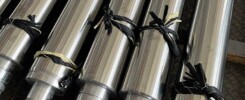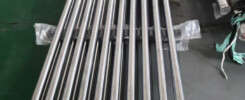Hard chrome plating is a cornerstone of hydraulic cylinder maintenance due to its exceptional hardness and corrosion resistance. A properly applied chromium layer reduces wear, minimizes metal fatigue, and prevents contamination from moisture or debris. However, the plating thickness directly influences these benefits:
Thin Coatings (<0.05 mm): Prone to rapid wear, exposing the base metal to corrosion and increasing the risk of rod scoring.
Optimal Thickness (0.05–0.15 mm): Balances durability with cost efficiency, ensuring long-term resistance to abrasion and hydraulic fluid exposure.
Excessive Thickness (>0.15 mm): May lead to brittle coatings, micro-cracks, and premature failure under high stress.
The Relationship Between Hard ChromeThickness and Hydraulic Cylinder Lifetime
Wear Resistance
A thicker chromium layer (within recommended ranges) provides a robust barrier against abrasive particles in hydraulic fluids. Studies show that cylinders with uniform chromium plating experience up to 40% less wear over 10,000 operational hours compared to subpar coatings.
Corrosion Protection
In harsh environments (e.g., marine or chemical industries), a thicker chromium coating enhances resistance to rust and oxidation. However, improper application can create weak points, accelerating corrosion and shortening hydraulic cylinder lifespan.
Friction and Heat Management
Excessively thick plating may increase friction between the piston rod and seals, generating heat that degrades lubricants and accelerates component aging. Precision-machined coatings ensure smooth operation and thermal stability.
How to Optimize Chromium Plating for Maximum Hydraulic Efficiency
To maximize hydraulic system performance, follow these best practices:
Specify Industry Standards: Adhere to ASTM B653 or ISO 4527 guidelines for chromium plating thickness and adhesion testing.
Invest in Precision Coating: Partner with reputable manufacturers using advanced techniques like magnetron sputtering for uniform layers.
Regular Maintenance Inspections: Measure chromium thickness annually using ultrasonic gauges to detect wear before failure.
Common Mistakes to Avoid
Overlooking Base Metal Preparation: Poor surface cleaning or machining can compromise adhesion, leading to delamination.
Ignoring Operating Conditions: Adjust plating thickness based on load, speed, and environmental factors. For example, heavy-duty applications may require thicker coatings.
Conclusion
The piston rod chrome plating thickness is a balancing act between durability, cost, and performance. By selecting the right coating thickness and prioritizing quality application, industries can extend hydraulic cylinder lifespan, reduce downtime, and lower maintenance costs. Always consult engineering specifications and partner with trusted suppliers to ensure your hydraulic systems meet peak operational efficiency.


